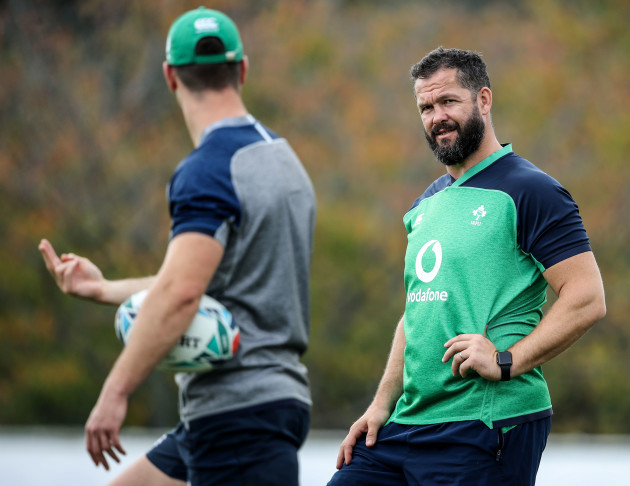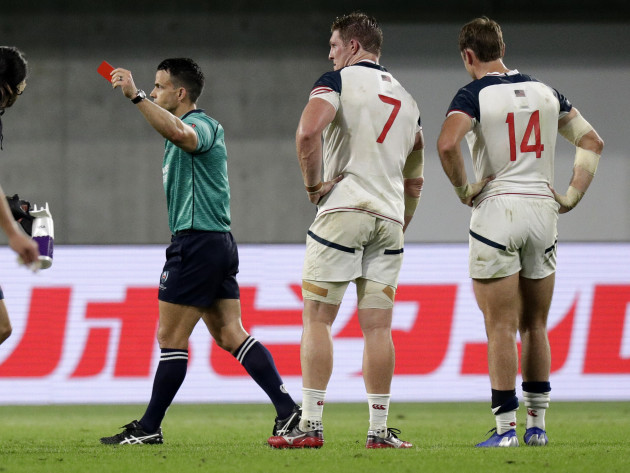WE KNEW THAT the issue of dangerous tackling was going to play a starring role at this World Cup and so it has proven the case.
There have been five red cards already in the 2019 tournament, more than the previous record of four in 1995 and 1999, with plenty of road still ahead for that figure to rise.
Three of those reds have been for dangerous high tackles, with USA flanker John Quill, Uruguay prop Facundo Gattas, and Argentina lock Tomás Lavanini the men sent off for making contact with opposition players’ heads.
There have also been bans for Samoa pair Rey Lee-Lo and Matu Motu’u, who should have been red-carded for their hits against Russia, while England’s Piers Francis somehow escaped a suspension after being cited for his head-high tackle against the US.
Australia’s Reece Hodge did cop a ban for his high shot against Fiji, All Blacks props Nepo Laulala and Ofa Tuungafasi were sin-binned against Namibia for high tackles, and there have been various other incidents drawing penalties or being missed.
Players and coaches had been well warned about World Rugby’s intent to stamp dangerous high tackles out of the game, but it has clearly been difficult for them to adapt their technique and intent to make a physical impact in the tackle.
Every defence coach in the game has this challenge to deal with, aware that one high shot could end their World Cup or deny them success.
Ireland’s Andy Farrell is no different and he has probably been discussing this topic even more than others, given that his son, Owen, has been on the receiving end of two red-carded head-high hits from Quill and Lavanini.
It’s worth stressing that World Rugby’s data shows that it’s the tackler who more frequently sustained a head injury in the tackle, rather than the ball-carrier, and the governing body’s hope is that tackle technique improves because of the severe sanctions for dangerous tackles – even if those sanctions remain inconsistently applied.
The proliferation of hugely aggressive linespeed has been the biggest change in the game in the past 10 years but improved technique often hasn’t been delivered to go along with that increased linespeed.
That’s where Farrell sees the scope for the game to get better – how defenders approach the tackle and specifically what they do with their heads.
The Ireland assistant coach, who takes over as head coach from Joe Schmidt after this World Cup, believes that everyone will be safer if the tacklers can improve their technique.
Asked about the issue of tackle technique yesterday, Farrell launched into a passionate speech in which he stressed the need for defenders not to drop their heads or turn them to the side as they tackle.
“Decision-making is defence, that’s what people don’t realise,” said Farrell. “It’s all about the decision before the actual contact itself.
“Chris Farrell got a bang with an elbow in his head [against Japan] and came off with an HIA. His head was to the side and when your head’s to the side or your head’s down, you’re not able to see exactly what’s in front of you at the moment that matters and then you’re not able to be in control of what happens to you at that stage.
“The funny thing that people don’t realise, and I’ll share it with you guys because it is important to get out there, it that it’s super-important to almost lead with your head.
“Let me explain that – you need to get your head through. If you don’t get your head through and square and your head’s not up, if you put it to the side and all of a sudden you start doing these ones…”
Here, Farrell turns his head to the side and leaves his arms outstretched, with his shoulder directed towards where a ball-carrier’s head might be.
“… can you see how now my shoulder comes off?
“If I lead with my head and get it through, then my head’s out of the way and that’s what we need to be coaching kids, 100%.
“I align it to skiing. When you’re trying to teach a kid how to ski, the hardest thing to do is say, ‘You’ve got to lean forward. You’ve got to lean forward because all your control is at the front.’ That’s how you shift around and that’s how you brake but it takes courage to do that.
“Proper technique, in my opinion, to make sure we’re looking after players, is making sure that we get the head through and not to the side because if it’s to the side you’re vulnerable.
“For example, if somebody’s a metre in front of me and I put my head down, then if he moves slightly, I’m not in charge of what happens to my head whatsoever.
“Again, if he’s a metre in front of me and I do this one [Farrell puts his head down again and leads in with a blind shoulder], I can’t see what’s in front.
“But if my head’s up and I’m trying to get it through, and when I mean through, I don’t mean through his chest, I mean through here [beyond the ball-carrier's midriff], get it out of the way and through the other side.”
“It takes proper courage to do that. Proper technique in my opinion, to make sure we’re looking after players is making sure we get the head through, not to the side, because if it’s to the side you’re vulnerable.
“I think kids need to be taught constantly about being comfortable with what proper technique is. It certainly isn’t throwing kids in there with their heads down and then getting hit on the head and them going, ‘I don’t know about this game’.
“Proper technique – it’s like anything, when you hit a golf ball sweet in the middle, you go, ‘Wow, that was fantastic’.
“When you get a tackle right it’s because you’ve got your head through and a square shoulder, you’ve not tackled with your arm and you get good contact and it feels right, it doesn’t hurt.”



